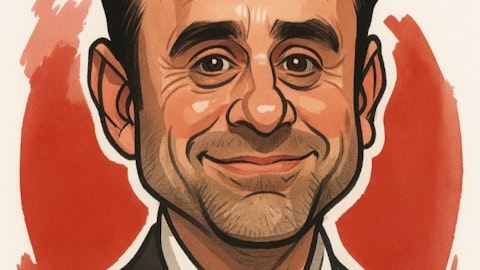Cadence Bank (NYSE:CADE) Q2 2025 Earnings Call Transcript July 24, 2025
Operator: Good day, and welcome to the Cadence Bank Second Quarter 2025 Earnings Webcast and Conference Call. [Operator Instructions] Please note this event is being recorded. I would now like to turn the conference over to Will Fisackerly, Director of Corporate Finance. Please go ahead.
Will Fisackerly: Good morning, and thank you for joining the Cadence Bank Second Quarter 2025 Earnings Conference Call. We have members from our executive management team here with us this morning, Dan Rollins; Chris Bagley, Valerie Toalson; and Billy Braddock. Our speakers will be referring to prepared slides during the discussion. You can find the slides by going to our Investor Relations page at ir.cadencebank.com where you’ll find them on the link to our webcast or you can view them to the exhibit to the 8-K that we filed yesterday afternoon. These slides are also available in the Presentations section of our Investor Relations website. I would remind you that the presentation, along with our earnings release, contain our customary disclosures around forward-looking statements and any non-GAAP metrics that may be discussed.
The disclosures regarding forward-looking statements contained in those documents apply to our presentation today. And now I’ll turn to Dan for his opening comments.
James Rollins: It was an active quarter for Cadence, both organically and for M&A. On the M&A front, we announced our acquisition of Industry Bancshares on April 25. We then completed our acquisition of First Chatham Bank effective May 1, and we closed the industry transaction on July 1. The announcement to close time line for industry was 67 days, which followed the 99-day announced to close time line for First Chatham. These achievements are the result of a tremendous amount of collaboration between the teams at each of the target banks and with the various regulatory bodies. We are excited about the opportunity to expand our presence in Georgia and Central Texas. We welcome these teammates and customers to the Cadence family.
Regarding the second quarter results, we continue to perform exceptionally well. Adjusted net income from continuing operations increased to $137.5 million or $0.73 per share, and adjusted ROA was 1.14% for the quarter. Our balance sheet growth drove a meaningful increase in revenue and our adjusted efficiency ratio improved by 90 basis points to 56.7%. Our loan growth once again highlighted the strength of our footprint. We achieved organic loan growth of $1.1 billion for the quarter or 12.6% annualized. The growth came across our geography and nearly all verticals with the highest growth coming out of Texas. Our community bank, corporate bank, private banking and mortgage teams all reported nice organic growth for the quarter, and our pipelines are strong and growing.
Our core customer deposit balances also showed growth, which offset some intentional runoff in brokered and a seasonal decline in public fund balances. Organic core customer deposits increased at a 4.4% annualized rate with the largest portion of this growth in noninterest-bearing deposits. Credit results continue to remain in line with our expectations with net charge-offs of 24 basis points annualized for the quarter. Finally, our tangible book value continued to improve, increasing to $22.94 per share and regulatory capital levels remained strong with CET1 of 12.2%. Now let me turn the call over to Valerie, and she can get into the weeds and the details for our financials. Valerie?
Valerie Toalson: Great. Thank you, Dan. To add to Dan’s comments, our pretax pre-provision net revenue for the second quarter increased to an all-time high of $206 million, up over 8% from the prior quarter driven by the balance sheet growth that Dan mentioned, combined with strong fee income performance and improved operating leverage. Average loans were up a little over $800 million in the quarter, while period-end loans grew by $1.4 billion, a $1.1 billion in organic growth and close to $400 million from the First Chatham acquisition. We also added just over $500 million in deposits from First Chatham in the quarter in addition to our organic core customer deposit growth of $376 million. These increases were partially offset by declines of $437 million in brokered deposits and $300 million in public funds.

Our period-end noninterest-bearing deposits as a percentage of total deposits actually increased this quarter to 22.6%. Average deposits were down, which is not unusual for the second quarter as seasonal runoff earlier in the quarter was offset by growth in the latter part of the quarter. Our second quarter total adjusted revenue was strong at $476 million, an increase of $28 million or 6%. Net interest revenue increased $15 million or 4% as a result of the robust loan growth as well as added securities. We added about $2 billion in securities in the late first quarter and early second quarter, funded by Federal Home Loan Bank term borrowings. These securities added nice revenue, but did result in a slight dip in the net interest margin in the quarter.
The NIM declined 6 basis points in the second quarter to 3.40%. And before considering the impact of the added securities, the quarter’s NIM actually increased 2 basis points as the trends in our earning asset yields and cost of funds were favorable. Loan yields were 6.34% in the quarter, up 1 basis point from the first quarter, and new and renewed loans in the quarter came on the books at just over 7%, which is well north of the total portfolio yield. Total cost of deposits also improved by 5 basis points linked quarter to 2.30% and time deposit costs improved by 12 basis points as new and renewed time deposits in the quarter came in over 30 basis points lower than the total portfolio rate. Adjusted noninterest revenue reflected great performance really across the board, increasing $13 million or 15% compared to the first quarter.
We had another big quarter in mortgage originations and the MSR valuation adjustment improved as well. Our wealth management teams also had a good quarter, benefiting from improved market conditions as well as seasonal tax revenue. And finally, other noninterest revenue increased just over $7 million, a combination of several items, including strong credit and customer swap fees, SBA income, Federal Home Loan Bank dividends and BOLI income. Adjusted noninterest expense increased $11.7 million linked quarter, mostly as a result of the closing of First Chatham combined with costs associated with business growth and strong operating performance. Salaries and employee benefits increased just over $4 million, about half of that related to FCB and the rest mostly due to increases in commissions and share-based payment accruals.
Data processing increased $3.6 million, partially impacted by higher business and project volume, and we incurred a seasonal increase in our advertising and PR expense. Legal costs were up $4.6 million, driven by final resolution of a legal matter and the decline in other miscellaneous expense of over $5 million was due to fraud and loss recoveries and lower consulting and regulatory expenses. Turning to credit on Slides 9 and 10. Net charge-offs for the second quarter were $21 million or 24 basis points annualized, which is down slightly from the first quarter and consistent with expectations. Nonperforming loans declined just under $5 million linked quarter, while nonperforming assets increased about $2 million. All in all, a stable linked quarter.
We did see an increase in criticized and classified loans linked quarter due to a handful of credits, but the balances continue to remain within historical ranges. The loan provision was $31 million, reflecting the day 1 provision of just over $4 million associated with acquired loans as well as the impact of loan growth in the quarter. Our allowance for credit loss coverage remained flat linked quarter at 1.34%. At this level, combined with our capital foundation laid out on Slide 16, we believe our strong balance sheet continues to be very well positioned. As a quick update on Industry Bancshares, we did close the transaction effective July 1, 2025. And as you may recall, industry had a sizable municipal portfolio. Once we closed, we immediately sold a large majority of that portfolio, liquidating $1.9 billion of securities and continuing to hold just under $600 million.
We have since used that $1.9 billion in liquidity to reinvest in $1 billion of securities yielding just over 5.25% with the remaining $900 million used to lower wholesale funding. Additionally, we put on about $550 million in notional interest rate swaps to minimize any residual interest rate volatility in these securities that remained on our balance sheet. Finally, we have updated our guidance on Slide 17 to reflect both the acquisition of First Chatham and Industry. We continue to expect solid loan demand for the latter half of the year, bringing full year loan growth, including the acquisitions to between 11% and 15%. This, combined with full year core customer deposit growth of between 12% and 15%, supports our expectation for total revenue growth between 10% and 12%.
We forecast continued operating leverage with expenses increasing between 7% and 9% in support of the growth in the balance sheet and continued investment in our future. Combined with stable credit, we expect these results will continue to drive strong EPS performance for us throughout the rest of this year. Operator, we would like to open the call to questions, please.
Q&A Session
Follow Cadence Financial Corp (NYSE:CADE)
Follow Cadence Financial Corp (NYSE:CADE)
Receive real-time insider trading and news alerts
Operator: [Operator Instructions] The first question today comes from Casey Haire from Autonomous Research.
Casey Haire: Can you guys hear me?
Unidentified Company Representative: Good to hear from you.
Casey Haire: Sorry, it’s been a little bit choppy. So I apologize if I’m in and out. But I guess, first off, I wanted to touch on the NII and the restructure. It feels like the margin can rebound to the [ mid-3.40s ] given what you did with the industry restructuring. Just wondering if I’m missing anything or just some help on the margin guide. And then also, are you guys — have you — is there any more restructuring to be done with the — on the consolidated balance sheet?
A – James Rollins:
A – Valerie Toalson:
A – James Rollins:
A – Valerie Toalson:
Casey Haire: Yes. Okay. Great. And then — so just switching to M&A. It just feels like it’s — activity is picking up here. You guys obviously have 2 deals under your belt year-to-date. Just wanted to get some updated thoughts on where you guys fit in and what appears to be M&A activity picking up.
A – James Rollins:
Operator: The next question comes from Manan Gosalia with Morgan Stanley.
Q – Manan Gosalia:
A – James Rollins:
A – Valerie Toalson:
A – James Rollins:
A – Valerie Toalson:
Q – Manan Gosalia:
A – Valerie Toalson:
Operator: The next question comes from Catherine Mealor with KBW.
Q – Catherine Mealor:
A – James Rollins:
A – Will Fisackerly: So the paydown activity was more robust in the first quarter, specifically in that larger merchant CRE and midstream space, and that was curtailed. And pipelines continue to be widespread, robust. The borrower activity with all the — sitting this time last quarter, we were feeling more uncertain. I think there’s still some thoughts of that, but borrowers talking to their vendors and clients, they’ve been able to formulate a strategy and the [indiscernible] loan pipelines are remaining as strong and the pull-through from our approvals is similar to what it’s been. It’s just the pipelines are stronger.
A – James Rollins:
A – Chris Bagley:
Q – Catherine Mealor:
A – Valerie Toalson:
A – James Rollins:
A – Valerie Toalson:
A – James Rollins:
A – Valerie Toalson:
Q – Catherine Mealor:
A – James Rollins:
Operator: The next question comes from Jared Shaw with Barclays.
Q – Jared David Shaw:
A – James Rollins:
Q – Jared David Shaw:
A – Valerie Toalson:
A – James Rollins:
A – Valerie Toalson:
Q – Jared David Shaw:
A – Will Fisackerly:
A – Valerie Toalson:
A – James Rollins:
Operator: The next question comes from Michael Rose with Raymond James.
Q – Michael Rose:
A – James Rollins:
A – Valerie Toalson:
Q – Michael Rose:
A – James Rollins:
Operator: The next question comes from Jon Arfstrom with RBC Capital Markets.
Q – Jon Arfstrom:
A – James Rollins:
A – Will Fisackerly:
A – James Rollins:
A – Will Fisackerly:
Q – Jon Arfstrom:
A – James Rollins:
Q – Jon Arfstrom:
A – James Rollins:
Q – Jon Arfstrom:
A – Valerie Toalson:
Operator: The next question comes from Ben Gerlinger with Citi.
Q – Benjamin Gerlinger:
A – James Rollins:
Q – Benjamin Gerlinger:
A – James Rollins:
A – Valerie Toalson:
A – James Rollins:
Operator: The next question comes from Olney with Stephens.
Q – Matt Olney:
A – James Rollins:
Operator: This concludes our question-and-answer session. I would like to turn the conference back over for any closing remarks.
James Rollins: I continue to be very confident that we’ve achieved both organically and through strategic partnerships in Texas and Georgia that we positioned ourselves to continue that momentum through the second half of 2025, and it sets us up in a position of strength for 2026. We appreciate everybody’s support on our call today. This concludes the call. We look forward to seeing you all again soon.
Operator: The conference has now concluded. Thank you for attending today’s presentation. You may now disconnect.
Follow Cadence Financial Corp (NYSE:CADE)
Follow Cadence Financial Corp (NYSE:CADE)
Receive real-time insider trading and news alerts




